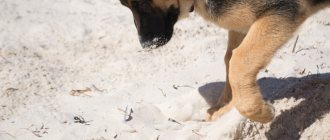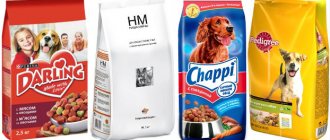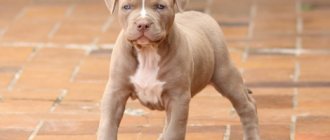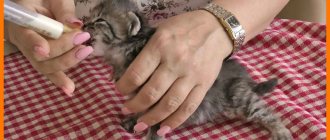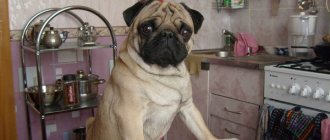Is it possible to give only this?
Ready-made complete feeds already take into account all the characteristics of the breed and select the ideal balance of proteins, fats and carbohydrates. Feeding only dry food is often practiced by owners. And by following the portion sizes recommended by the manufacturer, you can avoid significant health problems such as obesity.
Due to the brachiocephalic structure of the skull, when feeding wet ready-made rations, most of the muzzle ends up in the food. However, you should not completely exclude canned food from the menu. This problem can be solved by mixing dry and wet food.
A separate nutrition option is to use only natural products. The advantage is that the exact composition of the contents of the bowl is known, and if an allergy occurs, it is easier to exclude a certain component.
The downside is the fact that if the balance of food components is not maintained, your pug will gain weight very quickly. Also, in the case of such feeding, it is necessary to regularly donate blood to check the ratio of calcium and phosphorus in the body.
Leading food manufacturers have special breed lines that take into account the characteristics and needs of pugs.
Heat-treated potatoes
Potatoes that have undergone heat treatment contain fewer nutrients. Boiled potatoes are ballast for the dog’s body. With frequent feeding, the dog quickly becomes overweight. Heat-treated potatoes can be included in your pet's diet, but subject to certain conditions.
You can give boiled potatoes to dogs in rare cases and in very small quantities. Baked or boiled potatoes in their jackets are more suitable for their body. Tubers prepared in this way retain more nutrients.
Why can't dogs be given fried food? It's worse than boiled. With a minimal amount of nutrients, it contains a large amount of cholesterol. In addition, during frying, carcinogens are formed in the tubers - substances leading to the formation of cancer cells. Such potatoes also contain a large amount of fat, which has a detrimental effect on the liver and pancreas.
It is recommended to feed your pet only completely cooled potatoes.
Which one is best for these dogs?
Royal Canin
The company offers 2 types of dry food: for puppies from 2 months and for adult dogs from 10 months. In both types, the granules have a special trefoil shape, which makes them easier to grasp by brachycephalic jaws.
The inclusion of protein hydrolysates in the composition increases the digestibility of the feed, and vegetable oils provide an increased immune response of the body.
The main protein in the feed is poultry; it also contains corn and beet pulp. These components are quite allergenic and may not be suitable for dogs with hypersensitivity.
In puppy food, the guaranteed analysis of protein is 29%, fat 18%.
For adult pugs – protein 25%, fat 16%.
Hill's
It does not have specialized food for the breed, but offers a wide range of food for miniature breeds. For example, Hill's Science Plan is used as everyday food. The composition uses chicken and turkey protein, or lamb.
There are also specialized foods for small breed dogs with sensitive gastrointestinal tracts, skin problems, and excess weight, as well as separate food for puppies and older dogs.
The manufacturer guarantees an attractive aroma and a convenient round granule size. An undoubted advantage will be the ability to choose food specifically for the needs of a particular dog.
Acana
Produces holistic feeds. They do not contain cheap fillers and are often suitable for dogs with allergies. The price of such food is quite high, but sometimes it is the only suitable option. There are lines for puppies, adults and dogs with sensitive digestion.
The only disadvantage of this manufacturer, besides the price, is the high content of proteins and carbohydrates. This contributes to weight gain and a possible negative reaction to increased protein. This is usually manifested by the appearance of a reddish coating on the claws.
Pro Plan
It does not have a specialized line of daily diet specifically for the pug breed. In OPTISTART for puppies, OPTIBALANCE for adult dogs and OPTIAGE for small breed dogs over 9 years of age, chicken is the main source of protein.
The composition also contains corn, flavor enhancers, wheat, and gluten. All these components are strong allergens and may not be suitable for your pet. However, it is worth noting that veterinary diets take into account the highly specialized needs of dogs for certain diseases and cover literally all possible problems.
Monge
It also does not have a specialized breed line, but offers 26 options for miniature breed dogs.
This Italian manufacturer takes into account the various needs of small dogs, a wide selection of protein sources, and various vitamin and mineral supplements. There are no major allergenic components. The composition on each package is described in detail, as are feeding recommendations.
Brit
Produces premium, super premium and holistic food. Thus, Brit Fresh belongs to a high category of food and does not contain corn, wheat or other similar elements. But it is enriched with vitamins and minerals. It contains a large percentage of meat, and the source of carbohydrates is taken not from grains, but from potatoes.
There are dry food options for puppies and adult miniature breed dogs, as well as a variety of canned foods. Of all the lines from this manufacturer, the Brit Fresh line is most suitable for pugs.
Sample menu for a pug puppy by age
Up to 3 months, pug puppies are recommended to be fed natural food on a schedule according to the pet’s age. With this type of feeding, 70% of the diet comes from protein foods - meat, fish, eggs, milk and fermented milk products, 20% - from boiled and raw vegetables, 10% - from porridge. Let's look at a sample menu for a pug puppy by age.
Up to a month
Up to a month, babies are fed 6 times a day with their mother's breast milk or a milk substitute when bottle-fed.
- From 3 weeks, at the first feeding they give 50 g of milk with 2 g of honey, at the second feeding - 50 g of low-fat cottage cheese diluted with milk, and until the end of the day they are fed with a milk replacer.
- From the 26th day, at the 3rd feeding, give 30 g of ground boiled rice, oatmeal or buckwheat porridge.
1 month
From the 1st month, 5 meals a day are introduced. One new product is introduced into the puppy’s diet every day: raw meat, kefir, yogurt, grated cheese, raw grated carrots with sunflower oil, raw yolk, boiled fish, butter, rye bread, fruits and dried fruits.
The meat is given scraped for 5 days, then in small pieces, from 45 days you can treat the baby with soft lamb or veal bones.
- In the 1st and 2nd feedings, the baby is given 50 g of dairy products with honey.
- 3rd feeding – 50 g of porridge.
- 4-5th feeding – 10 g of meat.
2 months
At 2 months, boiled fish is added to the diet of a growing baby, which is given in small pieces 2 times a week, 30 g each. The puppy receives 30 g of meat or fish, 150-200 g of dairy products, 70 g of cereals and vegetables per day.
3 months
From 3 months, puppies are fed 4 times a day, increasing the portion size. Vegetables and fruits you can include in your diet include apples, zucchini, pumpkin, herbs, and bell peppers. During the period of teeth change, it is recommended to treat the baby with cartilage.
A puppy needs to eat 60 g of meat, 250 g of dairy products, 100 g of cereals and vegetables per day.
4-6 months
From 4 months, the pug is transferred to 3 feedings a day; boiled beef by-products are added to the puppy’s diet: liver, kidneys, heart, stomach.
In six months, a pet should consume about 150 g of meat or fish, 350 g of dairy products, 150 g of cereals and 200 g of vegetables per day.
6-12 months
From 7 months, it is advisable to feed your pet twice a day after a long walk. At the first feeding, porridge, fermented milk products or vegetables are given, at the second feeding, meat or fish. Serving size is calculated based on the dog's weight.
Inexpensive
When choosing an economical food option, you need to carefully study the composition. Most often, manufacturers replace high-quality ingredients with cheap fillers and thereby reduce the price. The situation with new Russian manufacturers is a different case. It is among them that you can find inexpensive food without dangerous additives.
For example, feed from the Grand Dog , produced in the Krasnodar region. According to the stated composition, the diet corresponds to holistic feeds, and at the same time has an economy class price level. Due to the lack of aromatic additives, the food is not always attractive to picky dogs, which is the only significant disadvantage.
A similar situation is with another Russian manufacturer – Zoomenu .
Another good food with a good price and good composition is Organix . The only downside is the presence of corn. However, if the pug is not prone to allergies, this food is perfect.
Canned food
If you have not yet decided what food to feed your pug, we recommend that you pay attention to high-quality canned food, which is available in a large assortment in pet stores today. It can be added to home-cooked foods. This type of food is also convenient because it is perfectly balanced, containing all the necessary minerals and vitamins that a dog needs. But its choice should be approached with caution, because the market offers not only truly high-quality products, but also formulations that can hardly be called food.
Choose products from well-known and well-established manufacturers, ask for the opinion of the breeder from whom you will buy the puppy, or seek help from a veterinarian.
Super premium class
In super premium food, at least a quarter of the composition is made up of meat components. If by-products are present, then exactly which ones should be indicated. All foods containing less than 25% meat are classified as premium. Also, food of this class should not contain flavor enhancers.
There is not much difference in the quality of food from different manufacturers. As a rule, the percentage of proteins and carbohydrates is almost the same. The only difference will be the addition of flavoring components such as vegetable oils, herbal or fruit extracts, which are different in each recipe.
Dry food
When pet owners start talking about what they can feed their pug, many are very skeptical about dry food. And this is most often associated with the unsuccessful experience of purchasing a low-quality product.
To finally decide what to feed your pug, read the rules that should be followed when using dry food:
- You should not alternate food from different manufacturers;
- do not mix different formulations in one feeding;
- Do not give your pug vitamin or mineral supplements;
- do not pour boiling water over the food - most of the vitamins will be destroyed;
- Do not alternate natural food with dry food.
Pugs that are fed dry prepared foods can soak the granules with kefir, yogurt or milk. Feel free to give your pet fresh vegetables and fruits as treats. The dog should always have free access to fresh, clean water. When changing the diet, do it gradually, carefully monitor the condition of your pet.
From six months to one year, pug puppies will be suitable for food in the “junior” category, and later, up to seven years, in the “standard” category. It should be understood that dry food has not yet been created that is ideal for all dogs. One dog eats a certain type of food with great pleasure, while the other, after sniffing it, leaves offended.
Pet owners, with the help of an experienced veterinarian, should select the very composition that is ideal for your little friend. Pug breeders recommend the following brands:
- "Canide."
- "Akana".
- "Origen".
- "Hills".
- "Ekanuba".
How to feed?
For pugs, with their tendency to be overweight, it is extremely important to follow a split diet. Access to clean water should be available around the clock.
How to calculate how many grams you need?
Exact feeding rates depend on factors such as the dog's age, weight and activity level. Each manufacturer indicates data in a table with recommendations on the packaging. On average, a pug weighing 5 kg requires from 60 to 80 grams per day.
How to translate to them?
It is very important that the transition to a dry diet is smooth and that the body has time to adapt to a new type of nutrition. They begin to introduce food gradually, replacing 1/8 of the diet per day. An important point is the separate supply of natural ingredients and finished granules. The entire transition cycle must take at least 7 days.
If you stopped eating
Sometimes owners are faced with a situation where their pet refuses dry food. In this case, you must first check the expiration date.
If everything is in order, but there is still no appetite, it is recommended to proceed according to the following scheme:
- the food is left for only 15 minutes, then removed until the next feeding;
- subsequent feeding should be smaller in volume than the previous one. For example. In the morning, your pet ate 2/3 of the bowl, at lunch you offer him not 2/3 of the first portion, but half of the morning amount.
What is it for? This creates an artificial shortage of feed. The pug seems to be able to eat more, but there is no food in the bowl. Since food remains available for only 15 minutes, in a very short time the dog begins to understand that it needs to eat everything and quickly. As a rule, no more than a week in this mode is enough to revive your appetite.
General nutrition tips
Pugs, like many other dogs, can eat anything. it is strictly forbidden to feed this breed with food “from the table” : they have a very sensitive gastrointestinal tract, which is why the dog can often get sick or even die.
Pugs are prone to obesity . That is why dogs should be fed according to a certain schedule at the same time, which is suitable for the age of the dog. If the pug refuses to eat, then it is better to put the bowl of food in a cold place and place it only for the next feeding.
Also, you should not offer pugs a supplement - a standard portion is enough to fill the dog.
The diet of representatives of this breed must include clean water (not from the tap) and milk , which helps the pug fight heartburn (and they suffer from it quite often).
It is very important that your pet's food is not too cold or hot. Also, it should not be liquid, since the pug's stomach is adapted to solid food.
It is advisable to give dogs of this breed raw meat without adding salt to it. It is better if it is low-fat varieties (poultry, beef). Poultry bones are a must, but they must be raw, since the pug’s stomach simply cannot digest boiled ones. Pets can and should cook stewed vegetables; they can be lightly salted.
As for dry food, it is much more convenient to use than natural food. The main thing is to choose suitable and very high-quality food for your pug.
Our article will tell you everything about the peculiarities of feeding the Yorkshire Terrier, because small Yorkies are picky eaters.
Do you know how to create a menu for German Shepherd puppies? Our experts have compiled a diet for adults and puppies.
Very few owners are able to withstand the pleading look of a Chihuahua when she asks for food from the table. The owner must know what can and cannot be fed to the Chihuahua so that your pet does not get sick.
What to do if you choked?
The opposite situation occurs when the pug has an excessive appetite. In this case, when eating food quickly, inaccurate swallowing of granules is inevitable.
The most severe complication will be food getting into the respiratory tract. At the same time, the pet begins to cough, choke, and spin around in place.
If your tongue begins to turn blue and breathing is clearly difficult, urgent help is needed.
To remove stuck food from the esophagus, sit your pug on your lap, with its back facing you. With your left hand you need to hold your head from above, slightly tilting it forward. With your right hand, clenched into a fist, make forward movements to the middle of the sternum, forward and upward.
How can I help besides this?
If food is stuck in the upper part of the esophagus, you may be able to remove it with tweezers. However, in this case, the help of a second person is necessary, since the procedure is unpleasant and resistance is inevitable.
If the manipulations do not bring relief to the condition, you need to take the pug to a veterinary clinic as quickly as possible.
For puppies
When choosing a diet for a puppy, it is best to give preference to the food he was on after birth from the breeder. The Starter lines are designed for bitches during pregnancy and for puppies up to two months of age.
For the pug breed, for raising litter, it is optimal to use feed from Royal Canin, as it is highly digestible, and from Monge, due to its impeccable composition. The transition to a different diet should be gradual so as not to cause stress to the puppy.
Rules for feeding puppies depending on the characteristics of the breed
The cute and affectionate pug is distinguished from other dogs by the physiological and anatomical features of the breed: a flat muzzle, a compact and stocky body, a small stomach, increased appetite and a tendency to obesity.
It is recommended that the diet for a growing puppy be designed in such a way that the dog’s body is provided with all the necessary nutrients, but does not contribute to obesity. Regardless of the choice of food, food for stocky babies should be of high quality, fresh, concentrated and solid.
Choosing a place and dishes
When choosing a place and utensils for feeding a nimble pet, the owner must take into account the anatomy of the dog’s muzzle and the need for cleaning after each meal. From the moment an inquisitive puppy appears in a new home, it is necessary to give him a special place for feeding, which should become permanent for the dog. In a city apartment, it is better to feed your pet in the bathroom or kitchen; in these rooms you can quickly remove traces of dirt from the floor and walls.
The optimal dishes for feeding pugs are flat bowls made of stainless steel or ceramics. It is easier for an unusual dog to eat from such dishes, and the folds near the nose are less clogged with food particles.
For a puppy, it is recommended to purchase two or three bowls for food, water and milk. After each feeding, the puppy's dishes must be washed in running hot water without using chemicals.
Important! Bowls with food and water should be placed at chest level in a special stand with brackets that allow the dishes to be raised as the dog grows. This measure is necessary for the correct formation of the skeleton and exterior breed characteristics.
Basic nutritional standards
The bowl of food should stand for no more than 20 minutes, after which the dog’s dishes must be removed to form food discipline. After each feeding, it is recommended to wipe the baby's face dry and clean the skin folds near the nose from food debris.
Advice! Snacking between meals is unacceptable, otherwise the baby will grow into a constant beggar.
It is necessary to dose the food in accordance with the age of the puppy, avoiding overfeeding. This is fraught with the development of obesity, shortness of breath, disruption of the gastrointestinal tract and premature aging.
- If your pug puppy eats food quickly and takes a long time to lick the bowl, you need to increase the size of the serving.
- Bloating and diarrhea in a baby indicate overfeeding; in such cases, it is better to reduce the amount of food.
Remember! In a healthy, moderately well-fed pug, the ribs and spine should be palpable under the layer of muscle.
Small dogs should not be treated to food from the human table to avoid the formation of bad habits.
Feeding schedule
It is recommended to feed puppies daily at the same time after a walk to develop conditioned reflexes and hormonal levels. The first meal should be no earlier than 7 a.m., the last meal no later than 10 p.m. A well-fed pet should rest for 1.5-2 hours for better digestion of food.
Small pugs have small stomachs, so small meals several times a day are appropriate for growing pets. The feeding schedule is made taking into account the age of the babies, from 5-6 to 2 times a day. It is recommended to maintain the same time interval between babies' meals.
- Babies up to a month are fed 6 times a day, at the age of 1-3 months - 5 times a day.
- Puppies 3 – 4 months old eat 4 times a day.
- At 4-7 months – 3 times a day.
- After 7 months, the dog can be switched to two meals a day.
Important! If you are forced to skip a feeding, you should not give the puppy a double portion. The next meal should consist of a regular portion according to the puppy's age and weight.
Water quality
A cute pet should have constant access to drinking water regardless of the animal's food choices. There should be a separate clean bowl for water, mounted on a stand with brackets.
Owner reviews
“For a long time we couldn’t get rid of our pug’s allergies. His ears were constantly running and the puppy was licking his paws. It was possible to completely change the picture when switching to Monge food. Within two weeks, all negative reactions stopped. He eats with great appetite."
Oksana Mazina, owner of a pug puppy.
“Initially, we fed our pug only canned baby meat, but at the veterinarian’s appointment we noticed that his tummy began to sag. We switched to Hills soaked in kefir. Everything is back to normal!”
Marina Glukhov, owner.
“The dogs have been in the kennel for a long time, we’ve tried different foods. We started feeding them with Proplan, but many developed allergies. We switched to Royal Canin - everything went away. We thought about switching to Acana, but it turned out to be too high in calories and the dogs quickly gained weight. So we returned back to the Republic of Kazakhstan (French production) and now everything is fine.”
Pavel Menshikov, breeder of pug dogs.
Veterinarian recommendations
“When choosing food for a pug, it is necessary to take into account the brachycephalic structure of the skull. The pug has a large round head with a rather short square muzzle and a tight bite.
The characteristic shape of the jaw and very thick lips do not allow pugs to easily grab food, as a result of which they often swallow kibble without chewing it. To avoid food getting into the respiratory tract, it is recommended to avoid using too small granules in the food.”
Konstantin Volsky, veterinarian.
“Skin with natural folds. The Pug's short coat accentuates the natural folds of its skin, especially around the muzzle. Moisture accumulates in folds, and for this reason they can become a source of dermatological problems. Regularly cleaning the folds and choosing dry diets helps reduce this risk.”
Vadim Kuznetsov, veterinarian.
Pregnant and nursing dogs
What to feed a pug (bitch) while waiting for or while feeding offspring? The animal’s diet is not much different from the usual one, but mineral and vitamin supplements and calcium supplements are added to it. In the first ten days, meat should be excluded from the bitch’s diet, as it can cause eclampsia, a disease characterized by convulsions and spasms.
Sometimes owners of puppy dogs say that the dog begins to be capricious during pregnancy: it refuses food, it can completely refuse meat in favor of ice cream or pickled cucumber, for example. Dog handlers do not recommend following your pet's lead. You just need to double the amount of vitamins and give vitamin K or a piece of liver every day.
Felines
Pugs are very curious by nature, and if there is also a cat in the house, trying someone else's food will be inevitable. However, systematic use is extremely dangerous for your pet.
Dogs and cats have different body needs and manufacturers take this into account when preparing diets. For example, cat food contains taurine, which often causes an allergic reaction in dogs.
A different balance of vitamins and minerals can lead to heart, kidney and liver problems if consumed over a long period of time. A high percentage of protein and carbohydrates causes obesity. Budget cat foods contain flavor enhancers that are addictive.
If your pet tries it once, there is no need to panic! To more quickly remove a possible allergen, it makes sense to give a sorbent, for example Enterosgel.
From 3 to 7 months
During this period of time, the kitten is actively developing. The puppy is already able to absorb a large portion at a time, this is the standard. The number of meals reaches up to four times a day. During the first and second meals, offer the puppy: kefir, cottage cheese with honey, vegetables, pieces of dark bread, fruit, quail eggs, herring (if the pet begins to eat).
During the third and fourth feedings, lean meat is prepared. Suitable: beef, hare, poultry, rabbit. The student may like lamb. There is no need to feed your puppy pork due to its high fat content. Meat is allowed to alternate occasionally with boiled fish. A seven-month-old puppy is gradually transferred to a three-times-a-day feeding schedule, and the amount of food offered should be enough to satiate.
